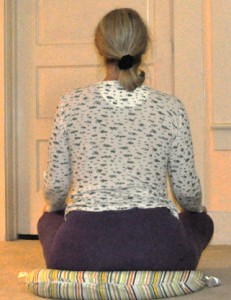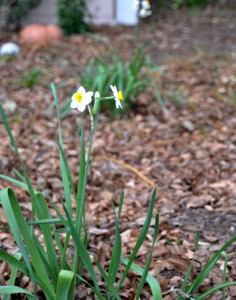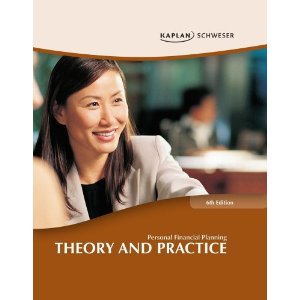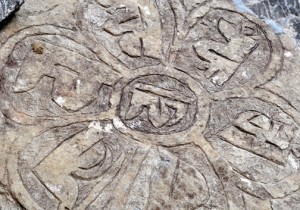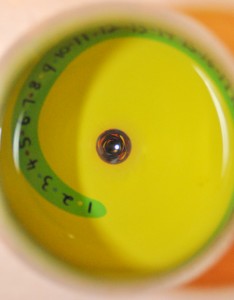 I’ve been feeling a shift. It’s not a change of seasons (we apparently aren’t leaving summer behind this year in Texas). I couldn’t describe what I’m feeling and thinking until I went to hear Richard Rohr, a Franciscan priest with dozens of inspirational books to his credit, speak about his latest, Falling Upward: A Spirituality for the Two Halves of Life, at my university Sunday.
I’ve been feeling a shift. It’s not a change of seasons (we apparently aren’t leaving summer behind this year in Texas). I couldn’t describe what I’m feeling and thinking until I went to hear Richard Rohr, a Franciscan priest with dozens of inspirational books to his credit, speak about his latest, Falling Upward: A Spirituality for the Two Halves of Life, at my university Sunday.
I have long understood that falling, or failing, or flaming out, or collapsing, or whatever happens that opens us to our suffering also opens us to the divine, so I get what Rohr is saying in the first half of the title. The notion presented in the second half fascinated me much more, that is Rohr’s description of the different main spiritual tasks that engage human beings in the first and second half of life.
Specifically, in the first half of life, Rohr says, we are building a container for our self. In the second half, we put aside concern for the container and begin to focus on knowing what is actually in the container. We become less concerned with building an identity and more interested in exploring what is actually incorporated in ours. My shift is, at least in part, in losing interest in my container and focusing my attention on what is inside the container and not caring what others might think of me. In addition, I find myself deeply curious about the process of letting go a little more of the container I worked so hard to build earlier in my life.
Building the container involves, for the most part, figuring out who you are not, if I understood Rohr correctly. We build the container for our self based on identification with our group, in Rohr’s case, feeling great about being a white, male American Roman Catholic from Kansas. Ideally, Rohr posits, when we compare this container with other possible containers, we find our own to be superior. Sunday evening he said that the healthiest people he knows grew up in “traditional” situations similar to his.
“Build your container,” Rohr said. “It’s ok. There’s not much depth, but we’ve got to do it.”
But we don’t have to focus on the container for our entire lives. “It’s not the best way to continue and certainly not the best place to end,” Rohr said.
Lots of people get so attached to their container, Rohr continued, that they dig in and defend it for the rest of their lives. Rohr doesn’t advocate tossing out the foundations you received in childhood, but he does think a well-lived life doesn’t stop with building a sound container.
“If you build your container well,” Rohr said, “You don’t need it [in the second half of life].”
In order to mature, we need to leave the tasks of the first half of life behind, but contemporary American culture makes that very difficult. “The United States is the only society that has idealized teenagers over elders,” Rohr said. “We’re not going to get anywhere by all wanting to be teenagers.”
Instead, we should develop wisdom and serve in the role of elder. When we have established a sound container, then we can move on to figure out what, exactly, is going on inside that container. Our failures and losses open the possibility of exploring the contents of our container (thus Falling Upward) and point us on the path to wisdom and to becoming elders of our community.
Rohr quoted the Dalai Lama in describing the transition from the first set of tasks to the second set. “Learn and obey the rules very well so you will know how to break them properly.”
In second-half-of-life tasks we let go of either-or, black-and-white thinking. We are no longer impressed by loudness and the shock factor of “bad words.” We learn to accept paradoxes, hold ambiguities. We learn that the law is not an end in itself and come to value mercy, justice and compassion over strict application of rules.
We seek wisdom, which is found not in the either-or, but in the principle of both-and. For Rohr, this means that we do not reject the church that helped to form our spirituality, but we challenge its assumptions by opening to other ways of thinking and accepting that, “[we’re] never 100 percent sure [we’re] right.”
Suffering is necessary to step into the second half of life (no matter one’s age). The necessity of suffering to heal and gain god’s mercy is a familiar theme for Christians. Rohr presents his idea that the mercy is present in the fall as well as the healing as a bit of an innovation. I probably wouldn’t have used the same words to describe my understanding of my own life, but I feel it.
The falls are not aberrations that activate me to crawl up out of the mud, instead, they took me into a space where I didn’t have to be cool or right. Where I was pretty darn sure that I was not often right, and where it didn’t matter if I was or not. Life went on. I agree with Rohr that we benefit from separating our thoughts about ourselves from our actual selves. He also made a great point about pitfalls of having a good reputation. “You’ve got to live up to it. You’ve got to pretend it’s true.”
I particularly liked Rohr’s answer to a question from an audience member who was concerned that he didn’t feel wise. “We don’t need great people,” Rohr told the man. “We need honest, humble people. They keep growing.”
Now, I have a new way to understand the path my thoughts are following, leading me deeper into the container. Maybe I’ll find some wisdom in here, maybe I won’t, but I’ll keep growing.
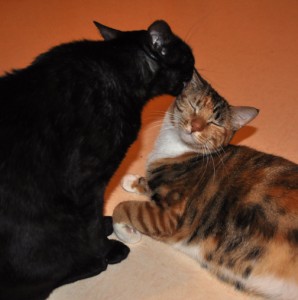 I almost gave up on the exercise several times, but I did stick with it for more than an hour. In the end, I whimpered a bit when I wrote that my purpose in life is to be loved by cats. It was late, and my cats were hanging around waiting to demonstrate their love for me by letting me feed them and then cuddling up with me for the winter night. I put the computer away and let my little colony shower me with affection.
I almost gave up on the exercise several times, but I did stick with it for more than an hour. In the end, I whimpered a bit when I wrote that my purpose in life is to be loved by cats. It was late, and my cats were hanging around waiting to demonstrate their love for me by letting me feed them and then cuddling up with me for the winter night. I put the computer away and let my little colony shower me with affection.

